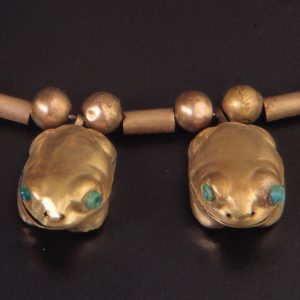StarStone is a monthly glimpse into the fabulous world of birthstones and the stories which have accompanied them for thousands of years into the modern day.
Each month and every zodiac sign are celebrated with several gemstones, varying by period, context and culture. While these designations are far from an exact science, exploring the historical context of your birthstones can serve as a window into revealing self-knowledge. And, offer yet another reason to buy yourself an amazing piece of jewelry.
In the case of December’s birthstone, many report a full-fledged mania. It’s called Turquoise Fever. Once bitten, there is no turning back.
Just ask self-described “geriatric starlet” Iris Apfel, now 100 years old. Iris understands the quintessential law of turquoise: more is more.
And let’s not forget Cher, who heaped on the First Nations treasure during the popularity of her so-un PC hit, “Half Breed.” This was also around the time when Cher, or at least her publicists, claimed that the singer possessed Cherokee ancestry. She doesn’t. But this Armenian-American celeb wore it iconically.
Experts concur that turquoise was one of the first gemstones to be mined. For anyone with even a smattering of French, “turquoise” means Turkish, because the first of these blue stones to reach Europe arrived via the Ottoman Empire which stretched east to Persia, the probable source of the stone.
From the burial mask of Tutankhamen to the splendid inlays of India’s Taj Mahal, turquoise conveyed the life-giving ease and refreshment of the oasis in ancient Asia, contributing to its divine status in arid desert lands. In antiquity, turquoise was revered as a talisman associated with precious water, endowing the gem with supernatural value, from the Middle East to the Moche society of pre-Conquest Peru, where shamanic ornaments in the form of golden frogs and toads, symbols of blessed spring rainfall, were further adorned with turquoise eyes.

This Moche nosepiece below features skilled turquoise inlay. According to the codex, priests wore this ornament to petition the gods for rain, the aquatic color of the gem reinforced by the shimmery gold pendants suggesting falling droplets, the “starbursts” at either end symbolizing the sound of thunder.

Americans are most familiar with seeing turquoise set in silver in the form of First Nations jewelry, often made by Dine (Navajo), Hopi and Zuni masters, who associate the gem with the sky.
However, masters of modern jewelry design like Dine artist Arland Ben may choose to set turquoise in gold as well as in sterling:

(Photograph by Arland Ben, Arland Ben cuff with Lander Blue turquoise set in 18 karat gold, courtesy of the artist.)
In his landmark essay, “Wet and Dry, The Evil Eye,” cultural anthropologist Alan Dundes discusses the relationship of moisture, water and the color turquoise to fending off the evil eye. On the most casual level, around the Mediterranean, doors are traditionally painted turquoise, and blue glass “eyes” still hang over entryways and around wrists for protection from…drying out. Dundes correlates being struck by the evil eye with dessication: men lose their vital procreative fluids, the breasts of nursing mothers cease to lactate, livestock shrivels, rivers turn to dust, and drought plagues the land. Ritual spitting—see “pooh-pooh-pooh” for a Jewish interpretation—has long been a secondary way of ensuring this protection.
Complex cultural associations surround turquoise among many indigenous nations. Today, Dine households may protect their occupants with pieces of turquoise suspended from the ceiling, sometimes in a handmade basket or pot. A Dine story tells of a goddess named Estsanatlehi, who was born from a turquoise nugget, and who is summoned during coming-of-age ceremonies.
In times of war, Apache warriors tied turquoise to their arrows, to improve aim and accuracy. Their Turkish counterparts did the same, embedding turquoise into their swords and armor as they went into battle.
On this continent, associations with rain persist in many traditional stories shared with non-natives, including songs from the Apache nation describing turquoise as rainfall appearing at the rainbow’s end, rain being even more valuable, perhaps, than the leprechaun’s pot of gold.
Collector, historian and storyteller Mike Ryan II lately of Santa Fe is co-author of two definitive books about turquoise culture: The Great American Turquoise Rush 1890-1910 reissued in a revised format in 2021 as Turquoise in America Part One, and Turquoise in America Part Two. His co-author is Philip Chambless, a turquoise prospector, lapidary and jewelry designer, and the book’s stunning photographs are the work of Dine master jeweler Arland Ben. Their publisher, Callais Press, LLC, is named for the Greek word for turquoise.

(Bisbee turquoise, photograph by Arland Ben, courtesy of Mike Ryan)
He says, “Turquoise has many looks both from different mines and from within the same mine. While I love all turquoise, I do have some personal favorites, including Bisbee, Lone Mountain and Lander Blue. Lander Blue, the most expensive of all turquoise, is known as a ‘hat’ mine, a mine of limited production which is so small it can be covered with a hat. It is fixed in turquoise lore, not only due to its rarity, high grade and price, but also because it was located by Rita Hapgood in 1973 due to guidance from a Ouija board séance.”
Ryan’s research places the first known turquoise mining in North America among the Ancestral Puebloan or Anasazi as early as 600 CE. He says, “Turquoise was mined in the southwest by the Ancestral Puebloan long before the Navajo migrated there during the 14th–15th centuries. At Pueblo Bonito in the ancient ruins of Chaco Canyon, over 60,000 pieces of turquoise have been found, primarily ceremonial in nature, and indicating an extensive turquoise trade route…These early miners relied solely on fire, water and stone hammers to extract turquoise and our story would not have been possible without their contribution.”
Placing the turquoise story into an even earlier context, in 1913 cultural anthropologist Berthold Laufer wrote in his treatise Notes on Turquois in the East, “To call a turquois a stone means an offense to the Tibetan, and he will exclaim indignantly, ‘this is a turquois, and not a stone.’ The Tibetan word for turquois, gyu, appears in the Mongol loan-word ughiu, and is indigenous property, being derived neither from Sanskrit nor Chinese.” (Spellings per Laufer’s original text.)
Ryan explains that for centuries, the robin’s egg blue-shade of a Tiffany gift box, without visible veins or matrix, was the desired color for this gem. Mountains of greener stone, discarded as worthless, have found a market only recently.
It’s worth noting that the beauty of turquoise is fragile compared with that of a diamond. Some of this has to do with porosity. Turquoise measures between a 5 – 6 on the Mohs Hardness Scale, making it far softer than a diamond which registers as a 10. A common complaint is that turquoise is barely harder than window glass. It is possible to scratch turquoise (by jostling it in a jewelry box containing harder stones and metal pieces, for example).
Constant exposure to sun, the natural acids in human skin, cosmetics, perfumes, and of course any contact with household cleaners and other chemicals can fade the brilliant blue. Even gentle, careful wear may eventually turn the color of the stone from azure to deep green if the surface of the stone is in close contact with the skin (as in a heishi choker, for example). With this in mind, some dealers choose to stabilize and enhance their stones, and present their goods honestly, in good faith.
The casual shopper in the American Southwest needs to be on guard, since doctored stones injected with plastic, treated with heat and paraffin, as well as dyed imitations and various other pretenders abound in the form of souvenirs. For this reason, Ryan recommends seeking out established masters of the jeweler’s art, and buying the highest grade of natural turquoise your pocketbook permits.
He says, “For a true turquoise lover, the comparison of natural turquoise to treated would be similar to a cheese lover comparing Velveeta to a fine Camembert. Respect is earned and turquoise, especially at its highest gem grade, comprising as little as 0.1% of all turquoise, is among the rarest of all gemstones and emanates a beauty, called Zat, that may be compared to brilliance in a diamond and luster in a pearl.”
The association of turquoise with Sagittarius, ruling the heavens from November 21 until December 21, is intriguing, beginning with the symbol of the sign: a centaur-archer taking aim. Reflecting back to the martial history of the gem in the Near East, Turkish armies believed the blue stone to be especially powerful in protecting their horses from falling in the battlefield, as well as sharpening the marksmanship of human warriors.
The centaur here is generally identified as Chiron, regarded as the great hunter who mentored Achilles in archery. Energetically ablaze with the Fire Element, and ruled by benevolent Jupiter, Sag is widely welcomed as a friendly, positive sign with virtually no place for shadowy thoughts or shady tendencies to hide.
Of course, Fire has its downside: when those billowing flames dance too high, Sagittarius can get burned out, and may even short-circuit and scorch others (though unintentionally) in the process. This is where the legacy of cooling, calming turquoise plays a role in balancing the archer’s temperament.
Sag may have a tendency to overheat, physically, mentally and emotionally. It’s not a coincidence that this sign literally runs smack-dab into the shortest day of the year, and the date of the winter solstice. The feeling of the solar year racing to its end can escalate into a manic panic in Sagittarius, fueled by the frantic nature of our consumer culture, as the last hours before Christmas dwindle down to zero!
And so, good-hearted Sag may turn into a pressure-cooker and blow a gasket as the holiday season climaxes. And especially around Sag’s birthday, when creamy, saucy and spicy delights accompany cocktails galore, sugar-plums, figgy puddings and all manner of heavy, rich food and drink, putting strain on the liver, the body organ ruled by Sagittarius.
Sag, we know you’re the life of the party, but do remember to eat some cleansing cooked greens and drink some green tea in between parties, to keep your insides balanced and your incandescent energy set to a steady, glowing burn.
Metaphysical gardeners recommend dandelion root to cleanse the liver of excess fat, and lemon balm to clear congestion in the belly caused by (urp!) festive overindulgence. Yellow dock is another Jupiterian plant, with spinach-like leaves that are yummy in salads, and help the liver to produce bile, much-needed for proper digestion. And, all of the above help ease constipation, which can be an unfortunate side-effect of gorging on fantastic holiday feasts!

(Vintage Old Pawn jacla necklace, collection of the author.)
In the Tarot, “Temperance” of the Major Arcana correponds to Sagittarius, so let this be your personal birthday and holiday card! Have your fun, but allow yourself to cool down between bashes, and try a piece of smooth, natural turquoise worn in such a way that the stone actually rests against your skin, to calm and center your powerful energy as you enter a new year.
___
Photo:Unsplash and Pexels




